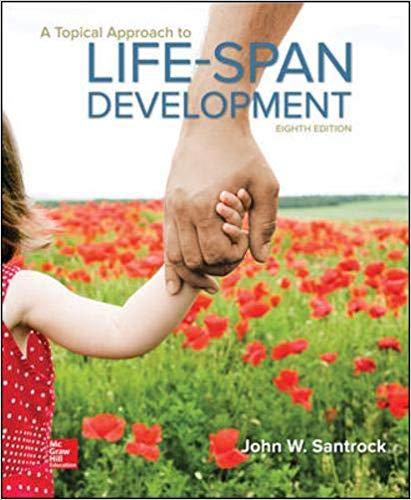Description
Test Bank For A Topical Approach to Lifespan Development 8th Edition By Santrock
Chapter 03 – Physical Development and Biological Aging
Multiple Choice Questions
1. According to the cephalocaudal growth pattern, which of the following is likely to show fast growth first?
A. legs
B. hands
C. brain
D. stomach
Page: 83 APA Outcome: 1.2
Bloom’s Taxonomy: Understand
Difficulty Level: Basic
Learning Objective: Discuss major changes in the body through the life span.
Topic: Patterns of Growth
2. According to the proximodistal growth pattern, which of the following is likely to show growth earlier?
A. toes
B. fingers
C. feet and hands
D. legs and arms
Page: 83 APA Outcome: 1.2
Bloom’s Taxonomy: Understand
Difficulty Level: Basic
Learning Objective: Discuss major changes in the body through the life span.
Topic: Patterns of Growth
3. Which of the following indicates that growth progresses from the top of the body to the bottom?
A. cephalocaudal
B. proximodistal
C. sarcopenia
D. lateralization
Page: 83 APA Outcome: 1.2
Bloom’s Taxonomy: Remember
Difficulty Level: Basic
Learning Objective: Discuss major changes in the body through the life span.
Topic: Patterns of Growth
4. In prenatal development, the head and its features grow in size and differentiation before the neck, shoulders, trunk, and limbs. What is this pattern of development called?
A. proximodistal
B. cephalocaudal
C. sarcopenia
D. lateralization
Page: 83 APA Outcome: 1.2
Bloom’s Taxonomy: Remember
Difficulty Level: Basic
Learning Objective: Discuss major changes in the body through the life span.
Topic: Infancy
Topic: Patterns of Growth
5. Which growth pattern sequence indicates that growth progresses from the center of the body toward the extremities?
A. cephalocaudal
B. proximodistal
C. sarcopenia
D. lateralization
Page: 83 APA Outcome: 1.2
Bloom’s Taxonomy: Remember
Difficulty Level: Basic
Learning Objective: Discuss major changes in the body through the life span.
Topic: Patterns of Growth
6. Baby Kassie can slap the tray of the highchair but cannot pick up small pieces of cereal with her fingers yet. This is an example of
A. a neurological disorder.
B. the cephalocaudal pattern in physical growth.
C. a congenital birth defect.
D. the proximodistal pattern in physical growth.
Page: 83 APA Outcome: 1.2
APA Outcome: 1.3
Bloom’s Taxonomy: Apply
Difficulty Level: Moderate
Learning Objective: Discuss major changes in the body through the life span.
Topic: Infancy
Topic: Patterns of Growth
7. Sammi was born 3 days ago and has lost 3 percent of her body weight. Should her parents be concerned?
A. Yes. Sammi’s parents should consult her pediatrician immediately.
B. No. Babies normally lose between 5 and 7 percent of their body weight within the first few days after birth.
C. No. Babies normally lose between 9 and 12 percent of their body weight within the first few days after birth.
D. Maybe. Sammi’s parents should begin supplementing breast-feeding with baby formula and weigh her twice a day to ensure no more weight is lost.
Page: 84 APA Outcome: 1.2
APA Outcome: 1.3
Bloom’s Taxonomy: Apply
Difficulty Level: Moderate
Learning Objective: Discuss major changes in the body through the life span.
Topic: Infancy
Topic: Weight
8. Average North American babies double their birth weight by what age?
A. 1 month
B. 4 months
C. 8 months
D. 10 months
Page: 84 APA Outcome: 1.2
Bloom’s Taxonomy: Remember
Difficulty Level: Basic
Learning Objective: Discuss major changes in the body through the life span.
Topic: Infancy
Topic: Weight
9. Marcia’s baby boy weighed 8 pounds at birth. How much should he weigh by 4 months of age?
A. 10 pounds
B. 12 pounds
C. 16 pounds
D. 24 pounds
Page: 84 APA Outcome: 1.2
APA Outcome: 1.3
Bloom’s Taxonomy: Apply
Difficulty Level: Moderate
Learning Objective: Discuss major changes in the body through the life span.
Topic: Infancy
Topic: Weight
10. During the second year of life, a child’s growth rate
A. remains the same as the growth rate in the first year of life.
B. accelerates considerably.
C. slows considerably.
D. accelerates for physical characteristics and slows for mental processes.
Page: 84 APA Outcome: 1.2
Bloom’s Taxonomy: Remember
Difficulty Level: Basic
Learning Objective: Discuss major changes in the body through the life span.
Topic: Infancy
Topic: Weight
11. Beginning in early childhood, girls have more _____ tissue than boys, and boys have more _____ tissue than girls.
A. fatty; muscle
B. organ; brain
C. brain; organ
D. muscle; fatty
Page: 84 APA Outcome: 1.2
Bloom’s Taxonomy: Remember
Difficulty Level: Moderate
Learning Objective: Discuss major changes in the body through the life span.
Topic: Early Childhood
Topic: Weight
12. During the early childhood years, girls are generally _____ than boys.
A. much larger
B. much smaller
C. slightly larger
D. slightly smaller
Page: 84 APA Outcome: 1.2
Bloom’s Taxonomy: Remember
Difficulty Level: Basic
Learning Objective: Discuss major changes in the body through the life span.
Topic: Early Childhood
Topic: Weight
13. Leon is unusually shorter than his peers. It could be because
A. he inherited the kind of genotype from his parents.
B. he suffers certain growth hormone deficiency.
C. his mother smoked while pregnant.
D. All of these answers are correct.
Page: 85 APA Outcome: 1.2
Bloom’s Taxonomy: Apply
Difficulty Level: Moderate
Learning Objective: Discuss major changes in the body through the life span.
Topic: Early Childhood
Topic: Height
14. Physical changes in middle and late childhood occur
A. at approximately the same rate as those in adolescence.
B. more slowly than those in early childhood and more quickly than those in adolescence.
C. in three rapid spurts.
D. in a slow, consistent manner.
Page: 85 APA Outcome: 1.2
Bloom’s Taxonomy: Remember
Difficulty Level: Basic
Learning Objective: Discuss major changes in the body through the life span.
Topic: Height
Topic: Middle and Late Childhood
15. Which of the following changes are most pronounced in middle and late childhood?
A. changes in proportions
B. changes in weight
C. changes in height
D. changes in brain size
Page: 85 APA Outcome: 1.2
Bloom’s Taxonomy: Remember
Difficulty Level: Basic
Learning Objective: Discuss major changes in the body through the life span.
Topic: Height
Topic: Middle and Late Childhood
16. What is the period of rapid physical maturation involving hormonal and bodily changes that occurs in early adolescence known as?
A. spermarche
B. gonadarche
C. puberty
D. menarche
Page: 85 APA Outcome: 1.2
Bloom’s Taxonomy: Remember
Difficulty Level: Basic
Learning Objective: Discuss major changes in the body through the life span.
Topic: Adolescence
Topic: Puberty
17. During early adolescence, girls are generally _____ than boys.
A. taller
B. stronger
C. heavier
D. smarter
Page: 85 APA Outcome: 1.2
Bloom’s Taxonomy: Remember
Difficulty Level: Basic
Learning Objective: Discuss major changes in the body through the life span.
Topic: Adolescence
Topic: Puberty
18. Girls’ first menstrual cycle is called
A. menarche.
B. monarchy.
C. estradiol.
D. puberty.
Page: 85 APA Outcome: 1.2
Bloom’s Taxonomy: Remember
Difficulty Level: Basic
Learning Objective: Discuss major changes in the body through the life span.
Topic: Adolescence
Topic: Puberty
19. Which of the following statements about growth spurts during puberty is TRUE?
A. It occurs approximately two years earlier for boys than for girls.
B. It occurs approximately two years earlier for girls than for boys.
C. It occurs at approximately the same time for boys and girls.
D. It is highly variable depending on individuals and occurs at a range of ages during adolescence.
Page: 85 APA Outcome: 1.2
Bloom’s Taxonomy: Apply
Difficulty Level: Moderate
Learning Objective: Discuss major changes in the body through the life span.
Topic: Puberty
20. Menarche occurs during what part of puberty?
A. just before puberty
B. early stage of puberty
C. in the middle of puberty
D. rather late during puberty





Be the first to review “Test Bank For A Topical Approach to Lifespan Development 8th Edition By Santrock”